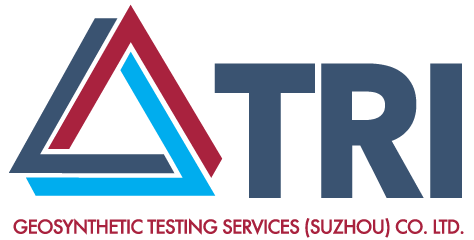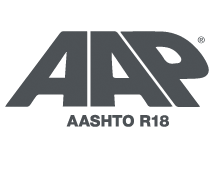Geosynthetics: Test & Capabilities
TRI is a full service global geosynthetics testing laboratory, GAI-LAP Certified and unaffiliated with any other engineering/design, manufacturing, installation or distribution firm. TRI has been servicing the geosynthetics industry for over twenty five years. TRI is well known for its rapid turnaround time, excellent project management and service. We recognize customer is crucial to construction driven installation schedules and we are driven to help each of our clients maintain their schedules. Each client is assigned a project manager who personally supports the shipping, receiving, testing and reporting functions of our laboratory and provides a knowledgeable direct point of contact for every client.
The testing equipment supporting the laboratory’s activities includes:
- a 600 kN (135,000-pound)capacity extented travel Instron model 5889 testing machine equipped with Bluehill 2 “Smart-Data” acquisition system
- a 200 kN (44,962-pound) capacity Instron Model 5585 testing machine equipped with Bluehill 2 “Smart-Data” acquisition system
- a 150 kN (33,721-pound) capacity Instron Model 5583 testing machine equipped with Bluehill 2 “Smart-Data” acquisition system
- a 5 kN (1,125-pound) capacity extended travel Instron Model 5565 testing machine equipped with Bluehill 2 “Smart- data” acquisition system; fixturing and support apparatus for diversified materials testing
- a 22,000-pound Instron Servo-Hydraulic Testing Machine with various direct-mounting extensometers
- 3 five station five-1000-pound load cell, screw-driven testing machines equipped with automatic data acquisition software to test multiple specimens concurrently
- load cells and instrumentation for the above with the capability to measure 1 lb to 100,000 lbs in tension or compression
- durometer hardness testers
- microtome precision cutting apparatus
- Mullen Model A burst tester with 2,500 psi capability
- hydrostatic resistance test apparatus
- 2 constant and 2 falling head permittivity apparatus
- 7 hydraulic transmissivity test apparatus
- 35 hydraulic conductivity test apparatus
- Pore size distribution test apparatus
GEOMEMBRANE
| RELEVANT STANDARDS | |
|---|---|
| ASTM D 7466 | Asperity Height |
| ASTM D 1603 | Carbon Black Content |
| ASTM D 4218 | Carbon Black Content |
| ASTM D 5596 | Carbon Black Dispersion |
| ASTM D 696 | Coefficient of Linear Thermal Expansion |
| ASTM D 1505 | Density |
| ASTM D 792 | Density/Specific Gravity |
| ASTM D 1204 | Dimensional Stability |
| ASTM D 751 | Hydrostatic Resistance |
| ASTM D 746 | Low Temperature Brittleness |
| ASTM D 1790 | Low Temperature Brittleness |
| ASTM D 2136 | Low Temperature Brittleness |
| ASTM D 1238 | Melt Flow Index |
| ASTM D 5323 | Modulus – 2% Secant |
| ASTM D 638 | Modulus – 2% Secant |
| ASTM D 638 | Modulus – Tangential |
| ASTM D 882 | Modulus – Tangential |
| ASTM D 3895 | Oxidative Induction Time – Standard (OIT) |
| ASTM D 5885 | Oxidative Induction Time – High Pressure (HPOIT) |
| ASTM D 5721 | Oven Aging at 85 °C |
| ASTM D 2124 | Plasticizer Molecular Weight |
| ASTM D 6636 | Ply Adhesion |
| ASTM D 4833 | Puncture Resistance – Index |
| ASTM D 1004 | Tear Resistance |
| ASTM D 751 | Tear Resistance – “Tongue Tear” |
| ASTM D 5884 | Tear Resistance – Large Scale “Tongue Tear” |
| ASTM D 6693 | Tensile Properties – Index (Dog Bone) |
| ASTM D 882 | Tensile Properties – Index (Strip) |
| ASTM D 412 | Tensile Properties – Index |
| ASTM D 7004 | Tensile Properties – Index (Grab) for Reinforced Geomembranes |
| ASTM D 7003 | Tensile Properties – Index (Strip) for Reinforced Geomembranes |
| ASTM D 4885 | Tensile Properties – Wide-Width |
| ASTM D 5617 | Tensile Properties – Multi-Axial |
| ASTM D 5199 | Thickness for Smooth Geomembranes |
| ASTM D 5994 | Thickness (Core) for Textured Geomembranes |
| ASTM D 1593 | Thickness by Weight |
| ASTM D 1203 | Volatile Loss |
| ASTM D 570 | Water Absorption |
| ASTM D 1239 | Water Extraction |
| ASTM E 96 | Water Vapor Transmission |
GEOTEXTILE
| RELEVANT STANDARDS | |
|---|---|
| ASTM D 4886 | Abrasion Resistance |
| ASTM D 4751 | Apparent Opening Size (AOS) |
| ASTM D 5101 | Gradient Ratio |
| ASTM D 4716 | Hydraulic Transmissivity – Planar |
| ISO 12958 | Hydraulic Transmissivity – Planar |
| ASTM D 6574 | Hydraulic Transmissivity – Radial |
| ASTM D 5261 | Mass per Unit Area |
| ISO 9864 | Mass per Unit Area |
| ASTM D 3786 | Mullen Burst Strength |
| ASTM D 4491 | Permeability / Permittivity |
| ISO 11058 | Permeability |
| ASTM D 5493 | Permittivity Under Load |
| ASTM D 6767 | Pore Size Characteristics Capillary Flow |
| ASTM D 4833 | Puncture Resistance – Index |
| ASTM D 6241 | Puncture Resistance – 50 mm probe (CBR) |
| ISO 12236 | Puncture Resistance – 50 mm probe (CBR) |
| ASTM D 4884 | Seam Strength |
| ASTM D 4632 | Tensile Properties – Grab |
| ISO 13934-2 | Tensile Properties – Grab |
| ASTM D 5035 | Tensile Properties – Strip |
| ISO 13934-1 | Tensile Properties – Strip |
| ASTM D 4595 | Tensile Properties – Wide-Width |
| ASTM D 5199 | Thickness |
| ISO 9863 | Thickness |
| ASTM D 4533 | Trapezoidal Tear Resistance |
GEONET/DRAINAGE GEOCOMPOSITE
| RELEVANT STANDARDS | |
|---|---|
| ASTM D 4218 | Carbon Black Content |
| ASTM D 1603 | Carbon Black Content |
| ASTM D 6364 | Compressive Behavior |
| ASTM D 1505 | Density |
| ASTM D 4716 | Hydraulic Transmissivity – Planar |
| ISO 12958 | Hydraulic Transmissivity – Planar |
| ASTM D 5261 | Mass per Unit Area |
| ASTM D 7005 | Peel Strength |
| ASTM D 6241 | Puncture Resistance – 50 mm probe (CBR) |
| ASTM D 7179 | Tensile Properties – Strip |
| ASTM D 4595 | Tensile Properties – Wide-Width |
| ASTM D 5199 | Thickness |
GCL
| RELEVANT STANDARDS | |
|---|---|
| ASTM D 5890 | Free Swell – Bentonite |
| ASTM D 5891 | Fluid Loss – Bentonite |
| ASTM D 6243 | Internal Shear Strength |
| ASTM D 7626 | Loss of Ignition |
| ASTM D 5993 | Mass per Unit Area |
| ASTM D5993 / D 2216 | Moisture Content – Bentonite |
| ASTM D 6496 | Peel Strength |
| ASTM D 5887 | Permeability / Hydraulic Conductivity / Flux |
| ASTM D 6766 | Permeability with Potentially Incompatible Liquid |
| ASTM D 6768 | Tensile Properties |
| ASTM D 4595 | Tensile Properties – Wide-Width |
GEOGRID
| RELEVANT STANDARDS | |
|---|---|
| ASTM D 4218 | Carbon Black Content |
| ASTM D 1603 | Carbon Black Content |
| ASTM D 7409 | Carboxyl End Group (CEG) |
| ASTM D 1505 | Density |
| ASTM D 7737 | Junction Strength |
| GRI GG2 | Junction Strength |
| GRI GG8 | Molecular Weight of PET (Average Number) |
| ASTM D 1388 / ASTM D 7748 | Stiffness / Flexibility |
| ASTM D 6637 | Tensile Properties – Single Rib |
| ASTM D 6637 | Tensile Properties – Multi Rib (Wide-Width) |
| ISO 10319 | Tensile Properties – Multi Rib (Wide-Width) |
During geomembrane installation, most CQA plans include third party destructive seam testing to assure the quality of the welds. HDPE or LLDPE Samples that are received at the Lab by noon will be reported same day via email. Other types of material seams can be tested but may not be reported same day due to special conditioning requirements. TRI also provides seam forensic capabilities to assist the project if and when any problems are encountered with dirty seams or welds marked by too much or insufficient heat, bad alignment, etc. We can use microtomes and photographs of observations to assist clients in responding appropriately to any quality assurance issue.
| RELEVANT STANDARDS | |
|---|---|
| ASTM D 6392 | Peel and Shear Strength -non reinforced geomembrane |
| ASTM D 751 | Shear Strength – Reinforced geomembrane |
| ASTM D 413 | Peel Strength – Reinforced geomembrane |
| ASTM D 6214 | Peel and Shear Strength – Chemical Welds |
| ASTM D 7272 | Peel and Shear Strength – Taped Seams (EPDM geomembranes) |
| ASTM D 7056 | Shear Strength – Pre-fabricated bituminous geomembrane |
High strength geosynthetic reinforcement products are often specified and it is important to confirm the characteristic high strength of these products. TRI is the highest quality laboratory in this regard as we employ a variety of state-of-the-art tension testing clamps and measurement systems. Included in this inventory of responsive tension testing technologies is the use of “Smart”-clamps, able to adjust gripping pressure based on the measured tension strength. These clamps adjust during testing to maximize the gripping pressure without damaging the material tested. Working together with non contact extensometry for strain measurement, TRI is able to test the strongest geosynthetic materials in the world. TRI also tests high strength component yarns and tapes, and high strength geosynthetic stitched and mechanical seams.
| RELEVANT STANDARDS | |
|---|---|
| ASTM D 48842 | Peel and Shear Strength -non reinforced geomembrane |
| ASTM D 751 | Shear Strength – Reinforced geomembrane |
| ASTM D 413 | Peel Strength – Reinforced geomembrane |
| ASTM D 6214 | Peel and Shear Strength – Chemical Welds |
| ASTM D 7272 | Peel and Shear Strength – Taped Seams (EPDM geomembranes) |
TRI performs creep/stress rupture testing for characterization of reinforcement geosynthetics:
- strain limit creep testing
- stress rupture limit testing
- development of reduction factors for creep/stress rupture (RFCR)
- accelerated creep and stress rupture testing using conventional time temperature superposition (TTS)
- accelerated creep and stress rupture testing using TRI developed Stepped Isothermal Method (SIM) testing
TRI also performs compression testing to measure normal-to-the-plane deformations of geosynthetic:
- Drains and/or liner systems
- Short and long term compressive strength of geosynthetic drains
- Short and long term compressive strength of geosynthetic liner systems
- Strain (deformation) measurements within liner systems
- Compression creep via conventional accelerated time temperature superposition (TTS)
- Compression creep via TRI developed Stepped Isothermal Method (SIM) testing
| RELEVANT STANDARDS | |
|---|---|
| ASTM D 2990 | Tensile, Compressive, and Flexural Creep and Creep-Rupture of Plastics |
| ASTM D 5262 | Creep and Stress Rupture |
| ASTM D 6364 | Short term Compression Behavior of Geosynthetics |
| ASTM D 6992 | Accelerated Tensile Creep and Creep-Rupture of Geosynthetic Materials Based on Time-Temperature Superposition Using the Stepped Isothermal Method (SIM) |
| ASTM D 7361 | Accelerated Compressive Creep of Geosynthetic Materials Based on Time-Temperature Superposition Using the Stepped Isothermal Method (SIM) |
| ASTM D 7406 | Time-Dependent (Creep) Deformation Under Constant Pressure for Geosynthetic Drainage Products |
| GRI GS10 | Accelerated Creep & Stress Rupture via Stepped Isothermal Method (SIM) |
| ISO 13431 | Creep and Stress Rupture |
| ISO 25619-1 | Determination of compression behaviour — Part 1: Compressive creep properties |
| ISO 25619-2 | Determination of compression behaviour — Part 2: Determination of short-term compression behaviour |
| ISO/TR 20432 | Guidelines for the determination of the long-term strength of geosynthetics for soil reinforcement |
The durability of geosynthetics and geosynthetic systems is often measured to ensure long-term performance. TRI is a world-wide leader in durability testing and offers considerable capabilities to meet regulatory-driven or product development needs. TRI responds to both environmental and load/construction durability concerns via large-scale and bench-scale testing of geosynthetics and their component materials. Some of the durability testing services and relevant standards are listed below.
| RELEVANT STANDARDS | |
|---|---|
| ASTM D 4886 | Abrasion Resistance |
| ISO 13427 | Abrasion Resistance |
| LA City L137 | City of Los Angeles Methane Barriers Certification (TRI-CA) |
| LA City L021 | City of Los Angeles Waterproofing Certification (TRI-CA) |
| EPA Method 9090A | Chemical Resistance – EPA |
| ASTM D 5496 | Chemical Resistance – Field Immersion |
| ASTM D 6141 | Chemical Resistance – GCL Clay |
| ASTM D 6213 | Chemical Resistance – Geogrids |
| ASTM D 5747 | Chemical Resistance – Geomembranes |
| ASTM D 6388 | Chemical Resistance – Geonets |
| TRI Procedure | Chemical Resistance – Geopipe |
| ASTM D 6389 | Chemical Resistance – Geotextiles |
| ASTM D 5322 | Chemical Resistance – Lab Immersion |
| ASTM D 3895 | Oxidative Induction Time (OIT) |
| ASTM D 5885 | High Pressure Oxidative Induction Time (HPOIT) |
| ASTM D 7409 | Hydrolysis – Carboxyl End Group (CEG) |
| GRI GG8 | Hydrolysis – Molecular Weight (MW) |
| EN 12447 | Hydrolysis Resistance |
| ASTM D 5818 | Installation Damage |
| ISO/TR 10722, ISO 13437 | Installation Damage |
| ASTM D 5262, ASTM D 6992, GRI GS10 | Long-Term Creep/Stress Rupture |
| ISO 13431, ISO/TR 20432 | Long-Term Creep/Stress Rupture |
| ASTM D 5721 | Oxidation Resistance |
| ISO/TR 13438 | Oxidation Resistance |
| ASTM D 1204/Extraction | Plasticizer Loss and/or Percent Plasticizer |
| EN 14030 | Resistance to Liquids |
| ISO/TR 12960 | Resistance to Liquids |
| ASTM G160 | Soil Burial / Biological Resistance |
| EN 12225 | Soil Burial / Biological Resistance |
| ASTM D 5397 | Stress Crack Resistance –Transition |
| ASTM D 5397, App. | Single Point Stress Crack Resistance |
| ASTM D 7238 | UV Resistance – Fluorescent |
| ISO 4892-3 | UV Resistance – Fluorescent |
| ASTM D 4355 | UV Resistance – Xenon Arc |
| ISO 4892-2 | UV Resistance – Xenon Arc |
| ASTM D 5970 | UV Resistance – Outdoor Exposure |
TRI has broad capability to evaluate the microstructural properties of geosynthetic materials. This capacity, in concert with our performance testing capability, is often employed to investigate the cause for geosynthetic seam problems or geosynthetic material failures. Senior technical staff bring their experience to bear on specific technical challenges encountered as geosynthetic materials are installed. Forensic investigation is also called upon when new and/or unknown materials are evaluated, or where premature field failures have occurred. TRI employs a variety of equipment to support forensic evaluations including a full service DuPont thermal analysis testing system (TGA, DSC, DMA, TMA) as well as analytical equipment (FTIR, GC/GCMS).
While traditional quality assurance programs have involved on-site sampling of product rolls after they arrive, they often resulted in expensive delays and costly corrections when subsequent testing identifies non-conforming product rolls. TRI has revolutionized this approach by establishing in-plant manufacturing quality assurance (MQA) inspection and sampling services.
Almost all TRI’s in-plant services are established in the host-city of the manufacturer of interest, thus eliminating the need for clients to pay for travel and lodging costs traditionally associated with MQA inspection and sampling events. TRI may secure samples from the manufacturing plant, ship to our laboratories and test in accordance with the CQA plan. The previously unaffordable is now financially feasible and of significant benefit.
| LOCATION | INSPECTION/MATERIAL SAMPLING FOR |
|---|---|
| Georgetown, SC | Agru America |
| Andrews, SC | Agru America |
| Fernley, NV | Agru America |
| Commerce, GA | Skaps |
| Pendergrass, GA | Skaps |
| Houston, TX | GSE Lining Company |
| Kingstree, SC | GSE Lining Company |
| Spearfish, SD | GSE Lining Company |
| Lovell, WY | CETCO |
TRI’s state of the art interface friction laboratory features 20 large scale direct shear boxes. Our loading capacity ranges from 50 to 40000 lb/ft2 (2-1900 kPa). Our in-house manufactured low load shear boxes provide our clients with improved testing and repeatability of interface shear strengths under cap and construction loading conditions (50-1000 lb/ft2, 2-50 kPa). Continued research in GCL hydration and consolidation, gripping and clamping systems ensures that TRI is the industry leader in interface friction testing.
TRI performs Interface Friction/Direct Shear testing to investigate slope stability:
- geosynthetic-geosynthetic interfaces
- soil-geosynthetic interfaces
- internal GCL shear and GCL interfaces
- large-scale soil shear strength
- long-term creep at the interface
- constant load or constant strain testing
| RELEVANT STANDARDS | |
|---|---|
| ASTM D 5321 | Direct Shear/Interface Friction |
| ISO 12957 | Direct Shear/Interface Friction |
| ASTM D 6243 | GCL Internal Shear and GCL Interface Friction |
TRI performs road base and asphalt reinforcement testing to characterize the improved performance of geosynthetic systems over traditional non-geosynthetic systems.
- Bench scale static and dynamic loading of reinforced road base structures
- Bench scale static and dynamic loading of reinforced asphalt structures
- Asphalt retention testing
- Confinement testing of geosynthetic reinforcement in road base courses
| RELEVANT STANDARDS | |
|---|---|
| ASTM D 6140 | Geotextile Asphalt Retention |
| TxDOT 3099 | Geotextile Asphalt Retention |
| Confinement Factor Determination | TRI Procedure |
| Asphalt Fatigue Benefit Ratio | TRI Procedure |
| Large Scale Trafficking | TRI Procedure |
TRI performs clogging potential for long-term filtration applications
- gradient ratio
- long-term hydraulic conductivity
- long-term residual flow
| RELEVANT STANDARDS | |
|---|---|
| ASTM D 1987 | Biological Clogging of Geotextile & Geotextile/Soil Filters |
| ASTM D 5101 | Soil/Geotextile Clogging Potential by Gradient Ratio |
| ASTM D 5141 | Silt fence Filtering Efficiency and Flow Rate |
| ASTM D 5493 | Permittivity Under Load |
| ASTM D 5567 | Hydraulic Conductivity Ratio (HCR) of Soil/Geotextile Systems |
TRI performs installation damage testing services to characterize the construction damage imparted to a geosynthetic as a function of installation. TRI has adopted a convenient method for applying installation damage to geosynthetics that allows for exhumation of the test samples while avoiding unintended damage. The method was developed and reported by Watts and Brady (1994) of the Transport Research Laboratory in the United Kingdom. TRI uses this procedure as modified to generally conform to ASTM D 5818 requirements.
The following construction quality control measurements are followed during exposure:
- Sieve analyses, as well as Proctor density and Attenberg limits analyses, as applicable, are performed on each soil/aggregate
- Lift thickness measurements are made after soil/aggregate compaction
- Moisture and density measurements are made on each lift using a nuclear density gage to confirm that densities >90% of modified Proctor (per ASTM D 1557) were being achieved
- Each geosynthetic is exposed to soils/aggregates chosen by the client from a range of available TRI maintained stockpiles having different gradations and representing fine grain sands to large angular gravels. Detailed particle size distribution curves and pictures are available for review
| RELEVANT STANDARDS | |
|---|---|
| ASTM D 5818 | Exposure and Retrieval of Samples to Evaluate Installation Damage of Geosynthetics |
| ISO/TR 10722 | Procedure for Simulating Damage During Installation |
| ISO 13437 | Method for Installing and Extracting Samples in Soil, and Testing Specimens in the Laboratory |
TRI performs connection and pull-out testing services to support the design of geosynthetic reinforced walls and slopes.
- MASONRY BLOCK connection and shear testing
- Constant strain or constant load testing
- Ceep/stress rupture at the connection
- RFCR of mechanical and friction connections
| RELEVANT STANDARDS | |
|---|---|
| ISO 13430 | Anchorage (Pull Out Resistance) |
| ASTM D 6638 | Connection Strength of Geosynthetic Reinforcement & Segmental Concrete Units |
| ASTM D 6706 | Geosynthetic Pullout Resistance in Soil |





